Menu
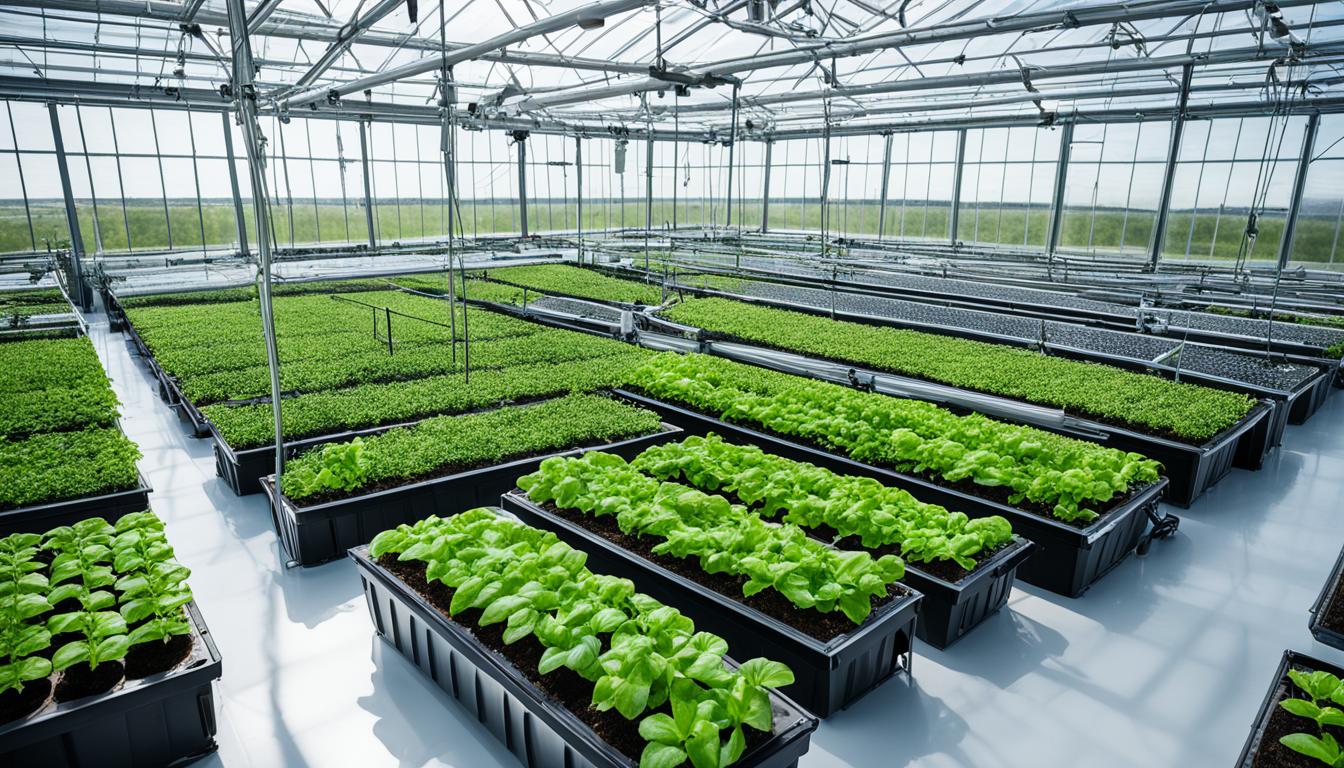
Smart greenhouse technology is making waves in the farming world. It’s changing how we grow plants by carefully controlling the environment. By doing this, plants grow faster, are more nutritious, and reach the point of harvest quicker. The core idea behind these technologies is simple but powerful: if certain conditions are met, then do this. This makes managing crops much easier than some other, more complicated farming methods.
These smart greenhouses do more than just control the environment. They can also water the plants perfectly by checking the moisture in the soil. And farmers can look after these systems from a distance, using apps and portable devices. So, they can spend more time growing their business and less time worrying about every little detail. Machines that can think for themselves are also part of the picture, helping make smart farming decisions and potentially saving farmers a lot of time.
The newest smart greenhouses are packed with features to supercharge crop growth. As time goes on, these technological wonders are set to transform agriculture like nothing before. They provide a lasting answer to the challenges modern farmers face. To learn more about how smart greenhouses and AI are changing farming, just click here.
The farming sector worldwide is facing climate change and shrinking resources. It’s also getting harder to feed a growing population. That’s why using the latest tech is now very important. Greenhouse automation and IoT in agriculture are two game-changers.
Smart greenhouses are more than just the usual. They use advanced sensors and communication. These tools keep watch on the environment and the plants all day, every day.
They look at things like temperature, humidity, light, and CO2 levels. Then, they send this info to a smart platform. This makes the data useful. And that helps control things like heating, lighting, water, and fertilising the plants better. As a result, the plants grow stronger and more efficient.
Smart greenhouses are changing the way we farm today. They cut down on the need for lots of workers. They also use resources and chemicals more wisely. This leads to bigger harvests.
Thanks to smart tech, problems like plant diseases are spotted early. This means crops are saved from big losses. Plus, these greenhouses create the perfect conditions for plants to grow. This boosts harvests even more.
Successful examples include Certhon’s big project in the Netherlands. It used 40% less gas. Then, there’s Sundrop Farms in Australia. Their greenhouse got 2.5 times more food out of plants with only 10% of the water. These wins show how smart greenhouses are making farming better and more sustainable.
Smart greenhouses use high-tech tools to help plants grow better and produce more. They mainly rely on three things: sensors, automation systems, and controls for the environment. These parts work together to keep the conditions just right for plants.
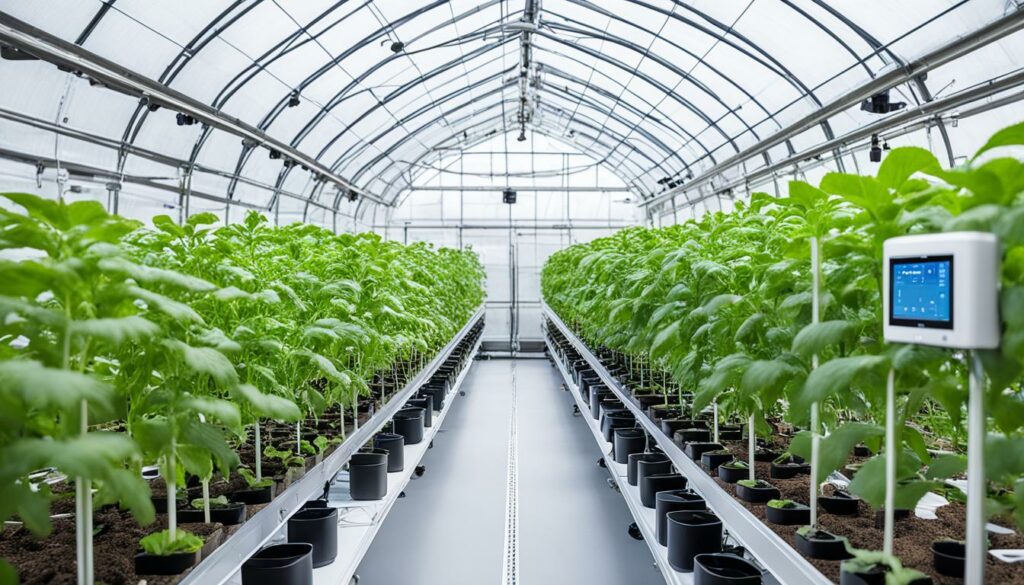
Sensors are key in smart greenhouses for checking the surroundings. They look at things like heat, moisture, and if the ground is too acid. By keeping an eye on these, the greenhouse can be adjusted to always give plants the perfect home. Top sensors, like those from ControlByWeb™, are needed for this job.
Across the world, about 14 million acres have greenhouses, with over a million in fixed buildings. Adding exact farming methods helps blow away old limits and make growing things easy and better.
Automation is changing the game in smart greenhouses. It takes care of watering and feeding plants based on what the sensors say. Special gear like the X-410™ Controller and X-405™ Module gives exact control. They go for about $300 to $330 and $220 to $250 each. This saves lots of work and makes growing plants more efficient.
Big greenhouse operations, such as Costa Farms, which sell $600 million in plants each year, love how they can keep quality high and use less work at the same time.
Getting the greenhouse climate right is core to good plant growth. For instance, the right carbon dioxide levels matter a lot, especially when using strong lights to grow crops. Tools like the X-420™ help keep these settings perfect. This tool is priced from $370 to $400. It’s very important for plant health.
Thanks to these high-tech parts, smart greenhouses are leading the way in farming. They use precise methods and help save the planet while making tasty food.
Greenhouse automation is changing how we grow crops. It uses sustainable farming solutions and smart farming innovations. These new ways are better for the environment and help us grow food more efficiently.
Automated irrigation systems are smarter than traditional watering. They use soil data to only water when needed. This saves water and makes crops better. For example, a farm in California cut water use by 30% and improved its lettuce quality with these systems.
Here’s how it works:
By saving water and making crops healthier, these systems show the best of sustainable farming.
Climate control in greenhouses makes perfect conditions for plants. They control temperature, humidity, and light. This helps crops grow better.
Keeping conditions steady helps farms run well and smart.
Also, data analytics platforms help farmers make good decisions about their crops. This cuts risks and boosts harvests. It shows how technology is making farming better for the future.
In recent years, IoT has become a big part of farming, especially in smart greenhouses. It’s changing how greenhouses work, making the agriculture IoT market worth $13.76 billion in 2022. Experts think this number will keep growing by almost 10% every year until 2030.
This growth is because IoT helps farms use resources better and make choices based on real data. It’s good for the planet and for making more food.
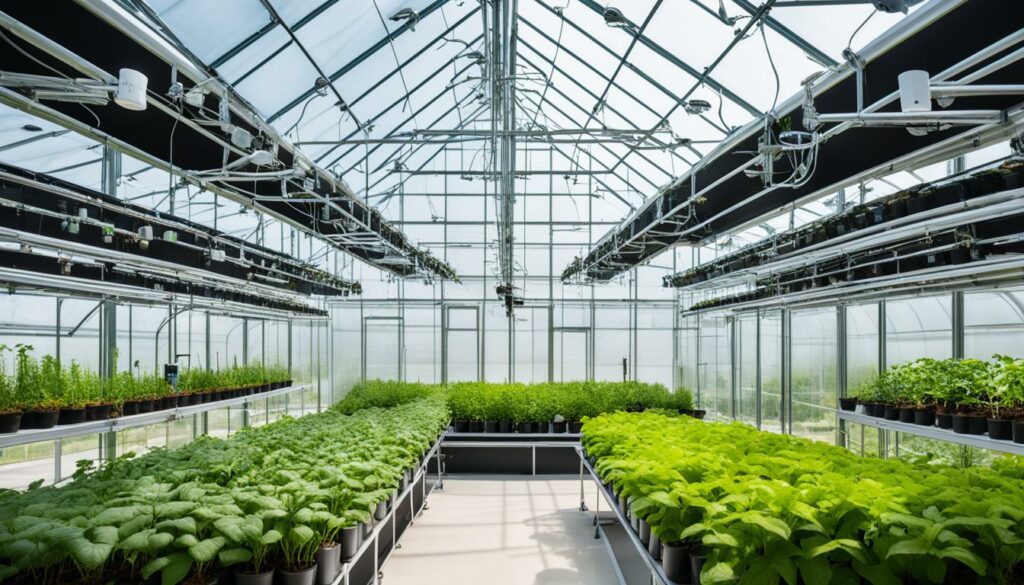
Putting IoT in smart greenhouses has made a huge difference. Greenhouses now have lots of sensors that watch everything from the air’s temperature to the soil’s moisture. This helps farmers know exactly what their plants need.
Gadgets like Farmapp and Growlink are making greenhouses smarter and more efficient. They automate tasks, making it easier for farmers to grow healthy crops.
Collecting data is key to making IoT in farming work. Sensors pick up information like how warm or moist the air is. This information gets sent to a central place for farmers to look at.
Thanks to gadgets like allMETEO and Pycno, every detail of the crop’s environment is checked. This ensures the crops grow as best as they can.
IOT is getting better and better at watching farm environments. And by 2025, smart agriculture could be three times bigger than it is now. These changes are vital for future farming, making food for everyone while looking after the planet.
Precision agriculture changes the face of farming with advanced tech and in-depth data analysis. This combo boosts farming to be more efficient, cheaper, and eco-friendly.
In precision agriculture, watching over crops has reached new heights. Thanks to satellite images and remote sensors, farmers get up-close looks at crop health, moisture, and field strength in real time. This data is key for smart choices in planting, watering, and harvesting times. Sensors in the soil and on crops give constant updates on nutrients, moisture, and soil health, helping farmers more precisely manage their crops.
Resource saving is key in today’s precision farming. Things like self-driving tractors and smart irrigation cut down on waste by being more accurate. Geographic Information Systems (GIS) help farmers understand their land better for improved farming. Big data crunches various info like weather, yields, and market need to predict trends, spot problems, and suggest fixes to grow more with less waste.
With the population expected to hit 10 billion by 2050, smart and eco-friendly farming is crucial. Erratic weather further underlines precision agriculture’s value. By merging different technologies, farms can use resources better, staying green and productive.
Smart farming is changing how we grow food. It uses high-tech systems to watch over the plants in smart greenhouses. These systems check on the air, the light, the water, and even bug levels. Farmers can see all this data from anywhere. This helps them make sure the plants are always in the best conditions.
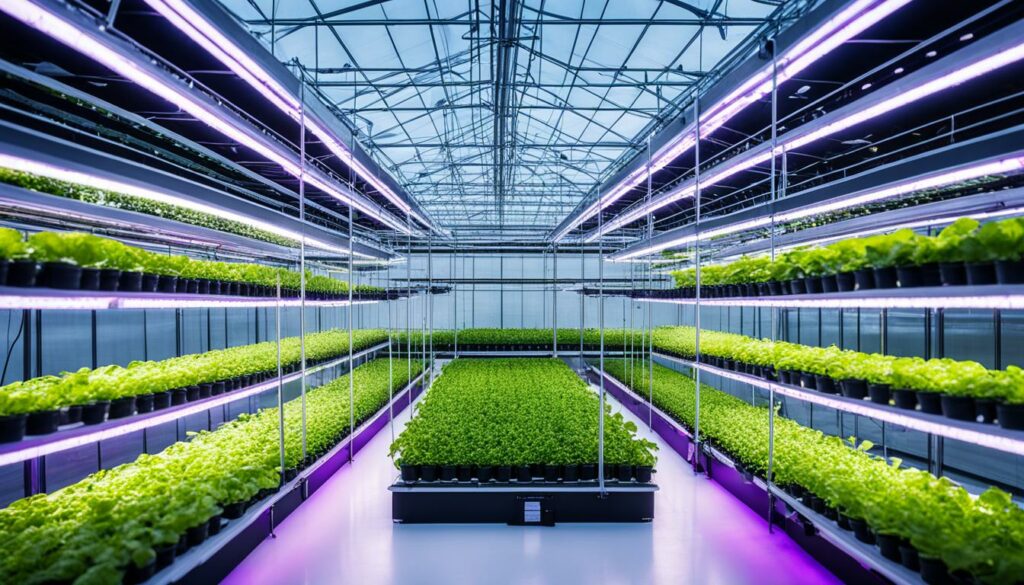
This kind of monitoring is very important. It keeps an eye on everything that affects the plants’ growth. For example, if it gets too hot or too windy, the system can send a message to the farmer’s phone. There’s even a way to watch the plants live on video, no matter where the farmer is.
Using past data, the systems can predict if there might be a problem with the plants. This early warning lets farmers take steps to keep the crops healthy. The system can also change things in the greenhouse on its own, like turning on extra light if the day is dark. This makes sure the plants have exactly what they need to grow well.
Smart greenhouses lead the way in sustainable farming by cutting down the need for water and fertilisers. They help tackle climate challenges by making agriculture more adaptable. This way, farms can stay strong against extreme weather and changing environments.
Smart greenhouses are incredibly efficient in managing resources. They use sensors and energy solutions to reduce water and nutrient waste. For instance, systems control the climate for the best crop growth. They adjust water and fertilisers precisely, cutting down on waste. This smart use of resources makes farming more sustainable and cheaper. Plus, the technology keeps an eye on the greenhouse environment. It protects plants and helps to produce better yields.
Smart greenhouses are great at handling changing weather. They have systems that respond to temperature, humidity, and light changes instantly. This helps crops stay strong when the weather shifts. Growers can use the automated climate control to keep conditions ideal year-round, no matter the weather. These systems are also good for the planet. They lower carbon emissions, backing eco-friendly farming. The industry is set to grow a lot, from USD 1.8 billion in 2022 to an expected USD 4.7 billion by 2032. This shows that more and more people are recognising the benefits of these advances.
| Key Market Segment | Technology/Component | End Users |
|---|---|---|
| Hydroponic and Non-Hydroponic | HVAC Systems, LED Grow Lights | Commercial Growers, Research & Educational Institutes |
IoT sensors play a key role in smart greenhouses. They monitor conditions and provide vital data for smart decisions. These gadgets make sure the environment is just right for plants. They also help save water and energy.
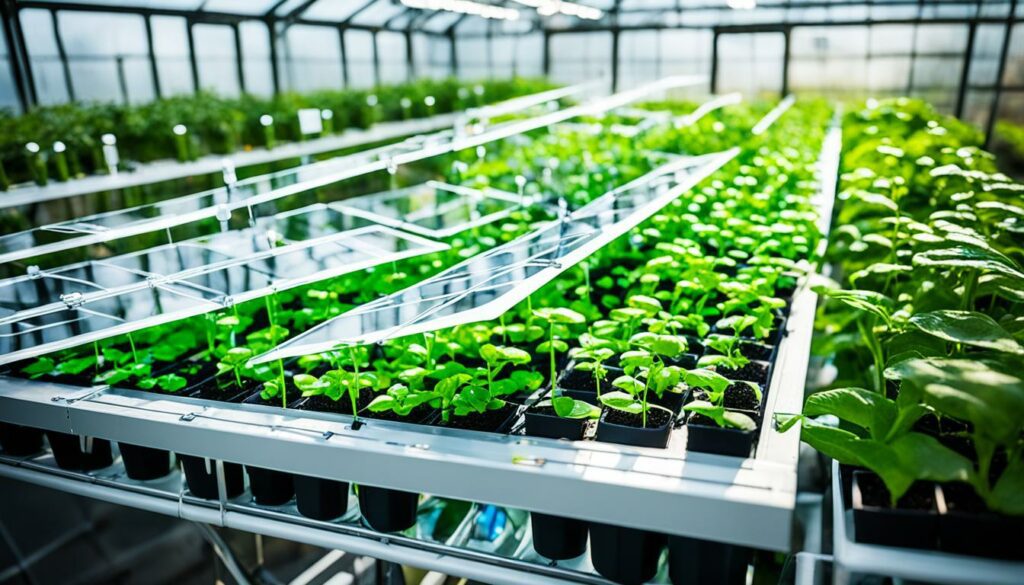
IoT’s data-driven system helps manage crops better. Farmers can act fast to lower risks without using as many chemicals. This way, they support the planet and save money. Yields go up and costs come down in IoT-powered greenhouses.
IoT sensors offer a big plus: they can check and adjust greenhouse conditions from afar. This means plants always get the best conditions to grow. Using real-time data, any problems can be tackled quickly.
By tracking and managing energy use, IoT sensors in greenhouses cut down on harmful gases. They fit into the farming chain well. This boosts the sector’s use of new ideas and research.
| Country | Greenhouse Area (Hectares) | Production (Tons) |
|---|---|---|
| Saudi Arabia | 3019 | 252,824 |
| Greece | 60,000 acres (Conversion needed) | Region specific (e.g., Messara, Ierapetra, Crete) |
Clearly, IoT is crucial for making greenhouses work better worldwide, especially with climate change. These sensors keep the climate perfect and improve how water and nutrients are used. They also help fight diseases and boost security. Using IoT is cheaper and more efficient than doing things the old way. So, it’s key for the success of smart greenhouses.
AI and machine learning are changing the way smart greenhouses work. They are key in making decisions and automating tasks. With the world’s population growing, making food supply stable while improving efficiency is crucial. Using AI in agriculture can offer answers to these big challenges.
AI’s ability to automate is making farming smarter. It does this by managing everyday chores and making them easier. For instance, companies like Blue River Technology have introduced self-driving tractors. These use AI to work by themselves, improving how much we can grow. This change helps with planting, watering, harvesting on time, and cuts down on mistakes. It all adds up to farming better, wasting less and doing more.
Using AI to make decisions quickly with a lot of data matters a lot. By studying huge amounts of information, machine learning can tweak greenhouse conditions very precisely. This process helps ensure plants grow in the best way, aiming for a 60% boost in food by 2030. As Lakshmi and Corbett have pointed out, AI can also spot pests early and warn of nutrient shortages. This early warning system helps protect plants, keeping them healthy.
Smart greenhouse technologies are becoming more popular. However, getting these technologies into greenhouses isn’t easy. There are technical and economic issues to solve. To really understand these problems and find good solutions, we need to look closer.
It’s hard to put lots of high-tech systems in greenhouses. Making sure all the parts, like sensors and computers, work together is a big challenge. And we can’t ignore the huge amounts of data these systems create. It can be overwhelming. Plus, new tech is always coming out. So, making everything work well and stay updated is tough. Solving these tech issues needs strong, reliable tech and ongoing help to keep things running smoothly.
Smart greenhouse tech is pricey at first. This can be a big problem for small farmers. Even tech that saves money later, like the Monarch Tractor’s MK-V, is hard to afford at first. Besides saving money over time, these systems also need money for upkeep and updates.
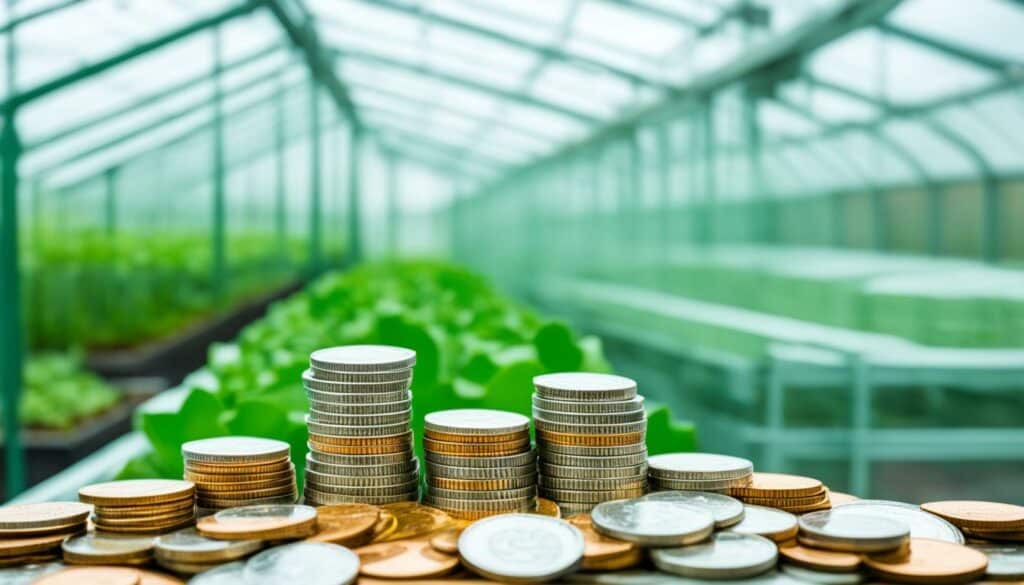
Solving these money and tech problems in smart greenhouses needs teamwork. Tech makers, governments, and farmers must work together. This teamwork is key to making smart greenhouses common and good for everyone.
When we look at smart greenhouses in case studies, we see they’re used in many places and ways. Costa Farms, for instance, is a big company that uses them to grow lots of plants every year. They make around $600 million. This shows us how smart greenhouses help a business do well.
Globally, about 14 million acres are used for greenhouses. Over 1 million acres are under sturdy roofs. This shows how important these technologies are for growing plants. They use things like the X-410™ Edge Programmable Controller. It has many cool features for managing the greenhouse. Such tools help make smart greenhouses work well.
The X-420™ module is another cool device. It has special features for checking the environment and making sure plants are happy. It can connect with many sensors, making accurate measurements. There’s also the XW-110 Wireless Temperature Sensor. It uses no wires and gives updates on plant conditions. These new technologies prove how smart greenhouses are getting smarter.
Around the world, smart greenhouses have been a success. In Qatar, these technologies have helped the greenhouse market grow. There’s also a smart system for managing greenhouses. It uses many sensors to save resources and keep plants healthy.
In another example, researchers worked on improving strawberry farms. They used smart tech to control the water used. This made plants grow well without wasting water. In Turkey, they tried this with tomato plants. Smart systems there also showed a big increase in production.
These case studies clearly demonstrate the benefits of smart greenhouses. They boost harvests, save resources, and are better for the planet. Putting advanced tech in farming can make a huge difference.
In the future, smart greenhouse technologies will change agriculture a lot. They will use things like IoT, AI, and automation to make farming both more efficient and sustainable. This development will keep getting better, bringing new, innovative changes.
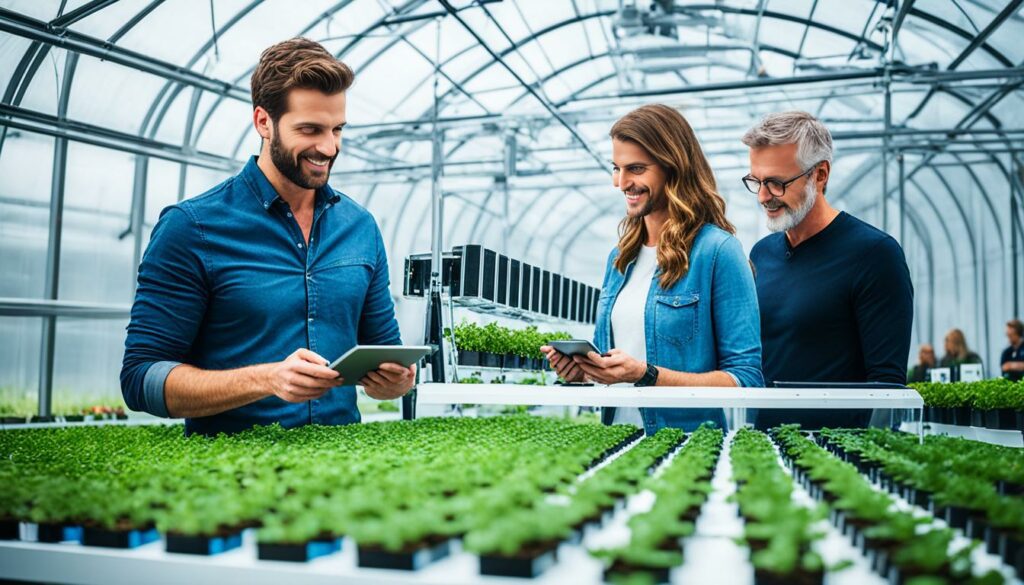
The smart greenhouse tech market is set to grow a lot. From USD 991.1 million in 2022, it’s expected to hit USD 1169.7 million by 2028. That’s a growth of 2.8% every year. New tools, like AI in predicting the weather or spotting diseases, are making big waves.
This growth means we’ll see more advanced PC Board Smart Greenhouses around. These now make up 50% of the smart greenhouse community. They’ll focus on being more automatic to cut costs and do better work.
The push for smarter greenhouses will be a big deal, especially in North America and Europe. These places own over 75% of the market. The changes promise to help with big issues like feeding more people while fighting climate change.
These advancements will help in tough times, like bad weather, boosting farming’s ability to endure. By 2028, they’re likely to grow and spread more, showing their power for good. The hope is for farming to be both more effective and friendly to the planet.
Smart greenhouses are changing the way we farm, covering almost 14 million acres worldwide. More than a million acres have these smart features in place permanently. They bring a host of advantages to farmers eager to use the latest technology.
One top benefit is higher yields. By precisely controlling the climate, these greenhouses create the perfect conditions for plants. This means fewer diseases and bugs and bigger, healthier harvests.
These smart setups also cut costs for farmers. By automating tasks like watering and adjusting light, they save on both money and energy. ControlByWeb‘s tools help make this possible by letting farmers manage many parts of their operation at once.
Costa Farms, which produces plants worth $600 million yearly, is a great example. They use advanced automation with ControlByWeb tools in their smart greenhouses efficiently. This shows that farms of any size can benefit a lot from this technology.
Smart greenhouses can control many aspects of the environment at once. They manage things like temperature, humidity, and light for up to eight or nine systems. This all-in-one approach helps save money and improve the quality of crops. It’s a win for both the planet and the farmer’s wallet.
| Key Benefits | Impact |
|---|---|
| Increased Yields | Optimised growing conditions and reduced disease incidence |
| Cost Savings | Reduced waste, labour costs, and energy consumption |
| Scalability | Applicable to both small and large-scale operations |
| Efficient Resource Usage | Automated control over irrigation, lighting, and temperature |
Keeping high-value crops safe in smart greenhouses is vital today. Thanks to IoT, we’ve made big steps in improving security. This helps protect crops from various dangers.
Now, smart greenhouses have top-notch theft prevention. IoT sensors keep an eye on any unauthorised access. They watch everything and alert the owner through a phone app instantly. This stops thieves and ensures quick action in case of any security breach, keeping the crops safe.
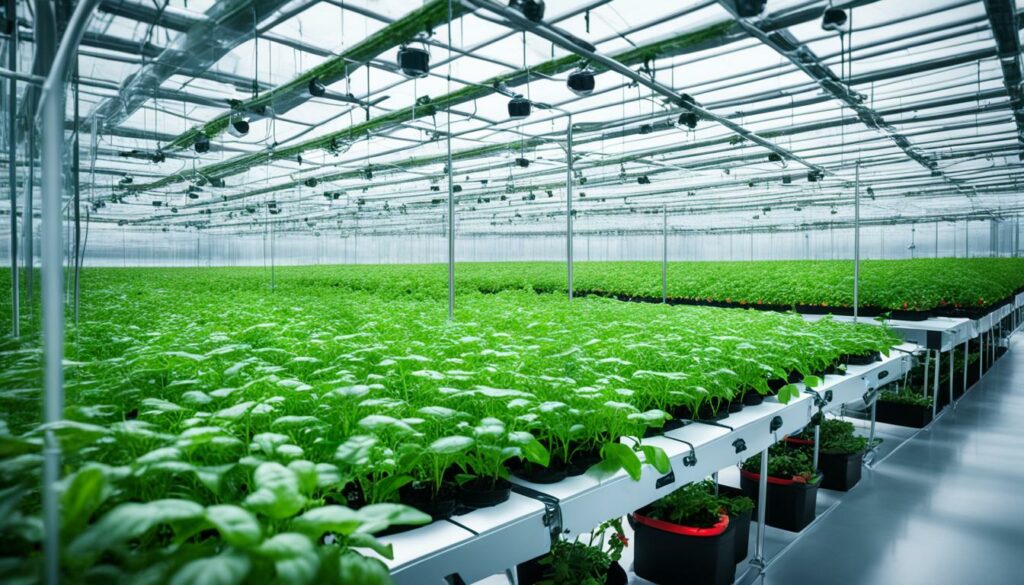
Dealing with sudden threats is crucial too. Things like sudden temperature changes or greenhouse damage can harm crops. When these happen, the system sends alerts right away. This quick warning allows for immediate action to protect the crops.
With these features, smart greenhouses tackle a wide array of risks. They’re not just about preventing theft. They provide a full safety solution for farming. This way, they help keep crops safe and farms productive.
Smart greenhouse technologies are changing the game in farming. They use the power of IoT, automation, and AI to create the perfect conditions for plants to grow. The result? Better crops and less damage from bad weather. A great example is a 30m² smart greenhouse in Vietnam growing Brassica Juncea. This greenhouse uses an Android app to watch and adjust things like temperature, humidity, and light.
Farming with precision means using sensors, robots, and drones to do the work. This doesn’t just make growing crops easier. It also helps keep an eye on animals by tracking their health and location. In smart greenhouses, wireless tech and automation handle jobs like making sure the plants have enough air, shade, water, and food. This makes everything more efficient.
But it doesn’t stop there. Adding smart analytics and AI takes farming to a whole new level. These tools help save water, take care of crops better, and even spot diseases early. Being able to manage greenhouses from a phone means farm professionals can spend more time working. As smart greenhouses become more common, they’re changing how we farm and helping keep our food supply safe. The future of farming is connected to these high-tech advances, making agriculture stronger and more sustainable.
Smart greenhouse technologies use sensors, automation, and IoT. They control the environmental factors needed for plant growth. These tools ensure the best conditions for plants and handle tasks like watering and feeding on their own.
Smart greenhouses are key in modern farming by reducing manual work through automation. They boost crop growth, manage resources well, and tackle challenges like uncertain weather and limited supplies effectively.
Key smart greenhouse parts are sensors, automation, and controls. Sensors track temperature, humidity, and soil moisture. Automation deals with watering and feeding, while controls keep the climate just right for plants.
Greenhouse automation changes how we grow plants. It includes automatic watering and controlling the climate. By using real-time data, it gives plants the exact water they need and keeps the environment just right, saving resources.
In agriculture, IoT means using sensors to monitor the environment. This data is then analysed by an IoT platform. It makes farming more efficient by suggesting better ways to manage crops, use resources, and predict disease.
Precision agriculture has improved thanks to smart greenhouses. They offer better crop monitoring and resource use. By giving plants the exact water and nutrients they need, we reduce waste and get more crops.
These systems keep a live track of the climate’s impact on plants. They use this data to predict diseases and how crops respond to the environment. This helps take early steps to protect plants and their yield.
Smart greenhouses cut down on water and fertilisers. They change with the environment, making farming more adaptable to climate challenges. This leads to practising sustainable farming in a better way.
IoT sensors are critical for smart greenhouses. They watch over and collect important data. This data keeps the growth condition perfect and deals with any health changes in crops quickly.
AI and machine learning help to manage big, complicated tasks in smart greenhouses. They analyse data and make the system better at handling the changing environment. This makes farming more efficient and less work for people.
Setting up smart greenhouses comes with technical and financial problems. These include getting systems to work together and the cost of starting. The answer is to keep making technology better and cheaper for farmers.
There are many successful examples of smart greenhouses around the world. These studies show how well these technologies work in different farms. They have led to more crops and better use of resources.
The future of smart greenhouses looks bright with more technology and new ideas. It could help with food security and handle the effects of climate change. These changes might make this technology a usual part of farming.
Smart greenhouses lead to more crops and save money for farmers of all sizes. They do this by creating the perfect growth conditions, reducing losses from disease, using resources well, and needing less work.
Enhanced security in smart greenhouses, like with IoT sensors, watches the place all the time. It helps stop theft and other dangers fast. This ensures that valuable crops are protected.